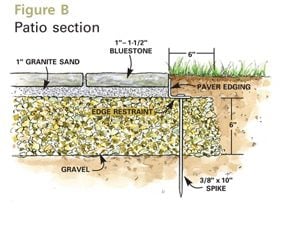Stone Patio Construction: A Comprehensive Guide
Introduction
A stone patio is a beautiful and durable addition to any home. It can provide a relaxing space to entertain guests, enjoy the outdoors, or simply relax. Building a stone patio is a relatively simple project that can be completed in a few days. However, it is important to plan and prepare properly to ensure a successful outcome.
Planning Your Patio
The first step in building a stone patio is to plan its size and location. Consider the following factors when making your decisions:
- Size: The size of your patio will depend on the available space and your intended use. A small patio is ideal for intimate gatherings, while a larger patio can accommodate larger groups.
- Location: Choose a location that receives plenty of sunlight and is well-drained. Avoid areas that are prone to flooding or erosion.
- Shape: The shape of your patio can be anything you like. However, simple shapes are easier to build and maintain.
Materials and Tools
Once you have planned your patio, you will need to gather the necessary materials and tools.
Materials:
- Pavers: Pavers are the stones that will form the surface of your patio. They come in a variety of materials, including natural stone, concrete, and brick.
- Base material: The base material will provide a stable foundation for your pavers. It can be made from crushed stone, gravel, or sand.
- Edging: Edging will help to keep your pavers in place and prevent them from shifting. It can be made from metal, plastic, or concrete.
Tools:
- Shovel: A shovel will be used to excavate the area for your patio and to spread the base material.
- Tamping tool: A tamping tool will be used to compact the base material.
- Level: A level will be used to ensure that your patio is level.
- String line: A string line will be used to mark the perimeter of your patio.
- Rubber mallet: A rubber mallet will be used to set the pavers in place.
Excavation and Base Preparation
The first step in building your patio is to excavate the area. Use a shovel to remove the sod and topsoil to a depth of 6 inches.
Once the area is excavated, you will need to prepare the base. Spread a layer of base material over the excavated area and tamp it down until it is firm and level.
Setting the Pavers
Once the base is prepared, you can begin setting the pavers. Start by laying a row of pavers along the perimeter of your patio. Use a level to ensure that the pavers are level and that they are flush with the edging.
Once the perimeter is set, you can begin filling in the center of the patio. Lay the pavers in a staggered pattern, making sure that the joints between the pavers are tight. Use a rubber mallet to tap the pavers into place.
Finishing Touches
Once the pavers are set, you can add finishing touches to your patio. This may include adding a border, planting flowers or shrubs, or installing a fire pit.
Maintenance
Your stone patio will require minimal maintenance to keep it looking its best. Sweep or hose off the patio regularly to remove dirt and debris. You may also need to re-seal the pavers every few years to protect them from the elements.
Conclusion
Building a stone patio is a rewarding project that can add beauty and value to your home. By following these steps, you can create a beautiful and durable patio that you will enjoy for years to come.
Additional Tips
- When choosing pavers, consider the climate in your area. Some materials, such as natural stone, are more durable in cold climates than others.
- Be sure to compact the base material thoroughly before setting the pavers. This will help to prevent the pavers from shifting or sinking.
- Use a level to ensure that your patio is level. This will help to prevent water from pooling on the surface.
- Seal the pavers after they are installed to protect them from the elements. This will help to keep them looking their best for years to come.
- Sweep or hose off the patio regularly to remove dirt and debris. This will help to prevent the pavers from becoming stained.
- Re-seal the pavers every few years to protect them from the elements. This will help to keep them looking their best and prevent them from deteriorating.
